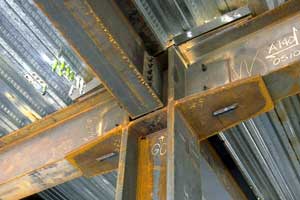Improving the Performance of Steel Moment Frame Connections
NEHRP Success Story
 "This project was a model of a well-managed program of design guidelines development, with results that have an immediate impact on building construction practices in the U.S. and elsewhere. The seismic safety of steel construction practices has taken a major step forward because of this project."
"This project was a model of a well-managed program of design guidelines development, with results that have an immediate impact on building construction practices in the U.S. and elsewhere. The seismic safety of steel construction practices has taken a major step forward because of this project."
-Michael D. Engelhardt, Professor of Civil Engineering, The University of Texas at Austin
One of the critical lessons from the 1994 Northridge earthquake was the unacceptable performance of steel moment-resisting frame construction. In response to that performance, FEMA established the FEMA/SAC Steel Moment Resisting Frames Project. When the extent of the problem became known, the earthquake engineering community faced a crisis. The building code for this type of construction had effectively been invalidated, and there was little idea of how safe existing buildings were or how to repair damaged buildings. Since FEMA funds the repair of publicly owned buildings, this was a crisis for FEMA as well as for building owners. It also quickly became clear that this was not just a California problem but also a national problem. FEMA determined that the first need was for guidance on how to repair damaged buildings. With funds from the Congressionally-authorized NEHRP Northridge Research Fund, the work was completed in less than a year and its primary product, the Interim Guidelines for Steel Moment Resisting Frame Construction (FEMA-267), quickly became the de facto standard. To date, FEMA has distributed over 20,000 copies of the Guidelines.
FEMA then began the second phase of the project, an effort to study and develop final design criteria for the design and inspection of new construction and upgrading of existing buildings for use by the nation's model building codes and standards. The final products include technical guidance for new construction (FEMA 350), upgrade guidance for existing buildings (FEMA 351), evaluation and repair guidance for damaged buildings (FEMA 352), and a technical specifications and quality control guidance document (FEMA 353). FEMA also published non-technical guidance for building owners and local officials (FEMA 354) and a CD-ROM with all of the publications and a series of background reports (FEMA 355).
This groundbreaking initiative was the first FEMA, if not federal, effort to effectively combine the academic research world and the earthquake engineering design community on a scale never before attempted. As a result of this effort, the building codes and standards for the entire country have been revised to take into account project findings. The quality of steel moment frame construction has been significantly improved because of the project. Both the model code organizations and the industry standards group are now using the final design guidelines as the basis for the next update of their products. In fact, the American Institute for Steel Construction is now sponsoring training courses across the country using the FEMA publications and has distributed several thousand copies to date.
FEMA has been widely recognized for its role in organizing and leading the solution to a serious problem for the nation's building codes and standards. The steel industry, through the American Institute for Steel Construction, presented an award to the Director of FEMA for its role in resolving this complex problem.
Last Modified: Friday, 19-Oct-2007 09:41:27 EDT

 Email Updates
Email Updates